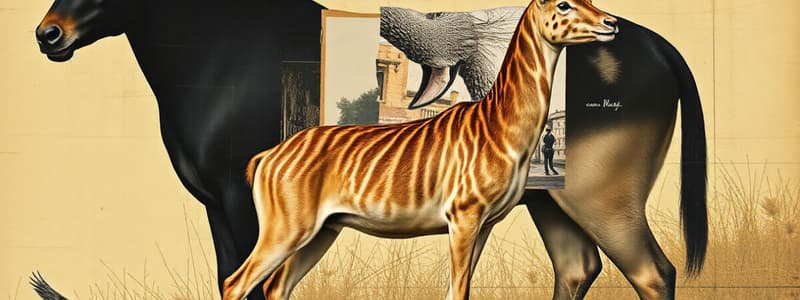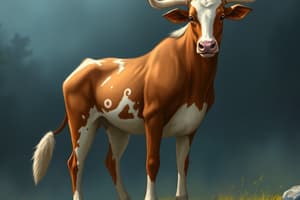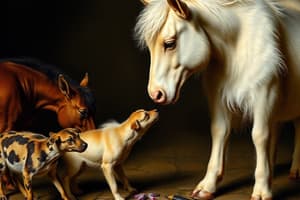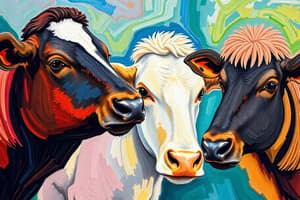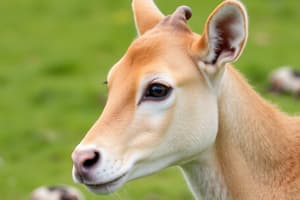Podcast
Questions and Answers
Which of the following best describes domestication?
Which of the following best describes domestication?
- The process of animals adapting to a new environment.
- The natural selection of traits that enhance an animal's survival in the wild.
- The process of an animal becoming tame through training.
- The process where a population of living organism is changed at the genetic level, this is through selective breeding that accentuates desirable traits that benefit humans in a variety of ways. (correct)
Belyaev's fox experiment involved selecting foxes solely based on their physical appearance.
Belyaev's fox experiment involved selecting foxes solely based on their physical appearance.
False (B)
According to the neural crest hypothesis, what occurs in the neural crest cells during domestication?
According to the neural crest hypothesis, what occurs in the neural crest cells during domestication?
Decrease in size
In the context of animal production, a castrated male pig is known as a ______.
In the context of animal production, a castrated male pig is known as a ______.
What is the primary purpose of supply management in Canada's dairy industry?
What is the primary purpose of supply management in Canada's dairy industry?
Colostrum is important for newborn calves because it provides essential immunoglobulins directly into their bloodstream.
Colostrum is important for newborn calves because it provides essential immunoglobulins directly into their bloodstream.
In the beef industry, what term describes the sector that manages cattle with forage or pasture diets, focusing on slow growth?
In the beef industry, what term describes the sector that manages cattle with forage or pasture diets, focusing on slow growth?
In the context of dairy production, the term for the period encompassing the lactation cycle through the lifespan of a cow is known as ______.
In the context of dairy production, the term for the period encompassing the lactation cycle through the lifespan of a cow is known as ______.
Match the breed of cattle to its physical traits:
Match the breed of cattle to its physical traits:
Which of the following is the correct terminology for a male chicken?
Which of the following is the correct terminology for a male chicken?
Canada exports substantial quantities of eggs.
Canada exports substantial quantities of eggs.
According to what you've learned about the history of horses, what was the first use?
According to what you've learned about the history of horses, what was the first use?
The Latin name for domestic swine is Sus scrofa ______.
The Latin name for domestic swine is Sus scrofa ______.
Which characteristic is most associated with Landrace pigs?
Which characteristic is most associated with Landrace pigs?
A key example of how dog domestication impacted the animal is this: domestication has NOT changed the way cats look and behave
A key example of how dog domestication impacted the animal is this: domestication has NOT changed the way cats look and behave
Which of the following traits is commonly observed as a result of domestication?
Which of the following traits is commonly observed as a result of domestication?
What is the primary objective of Belyaev's fox experiment?
What is the primary objective of Belyaev's fox experiment?
According to the neural crest hypothesis, domestication leads to a ______ in the size of the neural crest.
According to the neural crest hypothesis, domestication leads to a ______ in the size of the neural crest.
Match the domestication pathway with its description:
Match the domestication pathway with its description:
Which of the following is a characteristic of an extensive animal production system?
Which of the following is a characteristic of an extensive animal production system?
Colostrum is not important for newborn calves as they are born with a fully developed immune system.
Colostrum is not important for newborn calves as they are born with a fully developed immune system.
What is the purpose of supply management in the Canadian dairy industry?
What is the purpose of supply management in the Canadian dairy industry?
In beef production, forages such as pasture, hay, and silage are the 'Foundation of the Beef Industry' and represent the single greatest ______ cost.
In beef production, forages such as pasture, hay, and silage are the 'Foundation of the Beef Industry' and represent the single greatest ______ cost.
Which of the following is a key component of Canada's Traceability Program for cattle?
Which of the following is a key component of Canada's Traceability Program for cattle?
The Canadian poultry industry operates without any form of supply management.
The Canadian poultry industry operates without any form of supply management.
What is the Latin name for domestic swine?
What is the Latin name for domestic swine?
In swine production, a female pig of breeding age, but hasn't had piglets is called ______
In swine production, a female pig of breeding age, but hasn't had piglets is called ______
Match the horse coat colour with its associated health disadvantage:
Match the horse coat colour with its associated health disadvantage:
Which of the following is a detrimental effect associated with selective breeding for speed in horses?
Which of the following is a detrimental effect associated with selective breeding for speed in horses?
Flashcards
Domestication
Domestication
The process where a population of living organisms is changed at the genetic level through selective breeding for desirable traits.
Domestic animals
Domestic animals
Pets, cats, dogs, horses and cows.
Degrees of Domestication
Degrees of Domestication
- Wild (fight or flight) 2. Tamed (some dependence) 3. Semi-domesticated (human-animal relationship) 4. Domesticated (reliant on humans)
Changes due to domestication
Changes due to domestication
Signup and view all the flashcards
Belyaev's Fox Experiment
Belyaev's Fox Experiment
Signup and view all the flashcards
Tameness
Tameness
Signup and view all the flashcards
Neural Crest Hypothesis
Neural Crest Hypothesis
Signup and view all the flashcards
Commensal Domestication Pathway
Commensal Domestication Pathway
Signup and view all the flashcards
Prey Domestication Pathway
Prey Domestication Pathway
Signup and view all the flashcards
Extensive animal systems
Extensive animal systems
Signup and view all the flashcards
Intensive animal systems
Intensive animal systems
Signup and view all the flashcards
Supply Management in Canada
Supply Management in Canada
Signup and view all the flashcards
Importance of Colostrum
Importance of Colostrum
Signup and view all the flashcards
Indigenous Principles for Aquaculture
Indigenous Principles for Aquaculture
Signup and view all the flashcards
Canada's Traceability Program
Canada's Traceability Program
Signup and view all the flashcards
Hormones involved in Tameness
Hormones involved in Tameness
Signup and view all the flashcards
Cow
Cow
Signup and view all the flashcards
Heifer
Heifer
Signup and view all the flashcards
Bull
Bull
Signup and view all the flashcards
Steer
Steer
Signup and view all the flashcards
Calf
Calf
Signup and view all the flashcards
Sow
Sow
Signup and view all the flashcards
Gilt
Gilt
Signup and view all the flashcards
Boar
Boar
Signup and view all the flashcards
Barrow
Barrow
Signup and view all the flashcards
Broiler
Broiler
Signup and view all the flashcards
Layer
Layer
Signup and view all the flashcards
Distinct indigenous peoples of Canada
Distinct indigenous peoples of Canada
Signup and view all the flashcards
Quota
Quota
Signup and view all the flashcards
Study Notes
Domestication
- Domestication alters a living organism's genetic makeup through selective breeding for desirable human-benefiting traits.
- Domesticated animals include pets (cats, dogs) and livestock (horses, cows).
Degrees of Domestication
- Wild animals exhibit a "fight or flight" response.
- Tamed animals show some dependence on humans.
- Semi-domesticated animals have a human-animal relationship.
- Domesticated animals rely on humans.
Trait Changes Due to Domestication
- Adrenal glands relate to how tame the animal is.
- Melanocytes influence coat color.
- Chondrocytes impact skull size.
- Odontocytes impact teeth size.
- Domestication causes morphological changes.
- Floppy ears can develop.
Belyaev's Fox Experiment
- Foxes were selected based on temperament to simulate wolf domestication into modern dogs.
- The experiment began with 465 foxes.
- Initial behavior percentages: 30% extremely reactive, 40% moderately reactive, 20% fearful, 10% quiet & exploratory.
- The breeding criteria included assessing the flight threshold distance, or how close one can get to the fox.
Tameness and Hormones
- Tameness involves reducing the release of stress hormones.
- This results in a reduced fight-or-flight response and decreased reactivity to new situations.
- Hormones are produced by adrenal glands.
- Long-term hormones include glucocorticoids like cortisol, regulating neonatal development duration.
- Short-term hormones include catecholamines like epinephrine and norepinephrine.
- Domestic animals have a lower amount of these hormones compared to wild animals.
Neural Crest Hypothesis
- Genetic changes to neural crest cells cause domestication traits.
- Domestication leads to a decrease in neural crest size, reducing the population of cells derived from it.
- Tameness occurs due to reduced stress hormone synthesis.
- Cells producing stress hormones originate from the neural crest.
- A smaller number of cells involved leads to domestication syndrome.
Wolf Domestication
- Wolves with shorter flight distances could exploit human food waste, gaining a competitive edge.
- These wolves bred, developing domestication syndrome.
Domestication Pathways
- The commensal pathway involves habituation → partnership → directed breeding.
- The prey pathway involves prey management → herd management → directed breeding.
Animal Systems
- Extensive systems minimize capital inputs, use unprocessed, low-nutrient, high-fiber diets, and minimize handling.
- These systems manage beef cattle; sheep, and goats.
- Intensive systems use significant capital inputs, processed, nutrient-dense diets, confinement production, and economies of scale.
- These systems manage pork, dairy, and poultry.
Sector Types
- The cow-calf sector is for extensive production.
- Pasture and rangeland are used for extensive production.
- Backgrounding/stocker involves a forage/pasture diet and slow growth.
- Feedlot/finishing is for intensive production, using concentrate diets.
- The packing sector uses intensive production.
- Primarily, feedlots use some pasture.
Cattle Terms
- Cow: mature female
- Heifer: young female
- Bull: sexually mature uncastrated male
- Steer: castrated male before sexual maturity
- Calf: neonatal to 5 months of age
- Days in gestation: 283
- Days to get pregnant post calving: 82.
Pig Terms
- Sow: mature female pig
- Gilt: immature female pig before 2nd pregnancy
- Boar: mature male pig
- Barrow: castrated male pig
- Piglet: neonatal pig before weaning
- Farrowing: giving birth to piglets
Modern Swine Production
- It is an intensive industry where pigs are raised in total confinement and require high biosecurity.
- Breeding in modern swine production is done through artificial insemination.
- Gestation lasts 3 months, 3 weeks, and 3 days.
Farrowing Practices
- Sows are kept in individual crates.
- Average litter size is 15 piglets.
- Average birth weight is 1.2 kg.
- Colostrum intake is in the first 6 hours.
- Most sows have 12 teats.
Swine Weaning
- Swine weaning is abrupt, with piglets moved to a nursery.
- Piglets transition from milk to solid feed.
- Piglets are mixed with other piglets and are 21-28 days old at weaning.
Grow-Finish Stage
- After 5 weeks in the nursery, pigs are housed in large groups.
- Diets are changed as pigs mature.
- Pigs are ready for market in 15 weeks, weighing 125 to 130 kg.
Dairy Production Lifecycle
- Lactation cycle --> lifespan --> calves.
- Parturition/milk fever requires cows to mobilize large amounts of calcium from the skeleton.
- Insufficient calcium causes muscle tremors, staggering, lying flat, heart failure, and death.
- Treatment involves intravenous calcium.
Supply Management (Canada)
- A system to design milk production to meet Canadian demand.
- Limited milk and milk product exports and imports.
- Required quantity established for each province.
- Quota: A license to produce up to a set amount of milk.
- Production amounts and quotas are set per province by a national marketing agency.
- Producers are guaranteed minimum prices.
- High tariffs used to make Canadian products competitively priced.
Colostrum
- Calves are born without immunoglobulins in their bloodstream.
- The newborn's small intestine absorbs immunoglobulins into the blood for the first 24 hours (passive immunity).
- Antibodies: Y-shaped proteins, binding to bacteria and viruses to prevent disease.
Beef Production
- North American beef industry: production cycles, feeding operations.
- Key features, challenges, and opportunities in the Canadian beef industry.
- Forages are pasture, hay, straw, and silage.
- Forages have a major impact on cow-calf nutrition and management.
- Feed accounts for the greatest variable cost in beef production.
- Forages main focus: energy, protein, minerals, vitamins & water.
Canadian Traceability Program
- The Canadian Traceability Program is based on animal identification (radio frequency identification tags), premise identification, and animal movement.
- Individual ID and Premise ID are required for cattle leaving property.
Cattle Breeds
- Dominant breeds: Angus, Simmental, Hereford, Charolais, Limousin.
- Breeds vary in color, carcass quality, behavior, frame size, and feed efficiency.
Weaned Calf Sales
- Calves are sold in groups through auction mart to feedlot buyers, via Internet/Video sales, or forward contract with feedlot.
- Forward contract involves delivering calves for a pre-arranged price, eliminating the 'sale barn'.
Poultry Terminology
- Broiler: meat chicken.
- Layer: table egg production chicken.
- Rooster: male chicken.
- Tom: male turkey.
- Hen: female turkey or chicken.
Chicken Consumption
- In Canada, the supply management system ensures production matches consumption.
Supply Management System
- Characterized by family farms, it assures producers get a steady income with vaccines.
- Over 1000 broilers is considered commercial.
Poultry production
- Producers get a steady income and have a steady supply without oversupply.
- Provides enough money to support animal welfare initiatives.
- Boards have a say in animal welfare practices.
- Products are more expensive for consumers, and future producers must purchase quota.
Horse Evolution and Domestication
- Equus evolved in North America before migrating to Eurasia and spreading across the Eurasian steppes.
- Horses were hunted for food.
- Horses were raised in captivity and domesticated.
Historical Horse Use
- Horses use started with carrying and hauling.
- Then evolved to war tactics.
- Lastly, horses turned into riding.
Horse Colors
- Certain colors in horses, such as grey (melanomas), have selective disadvantages in the wild.
- Silver colors are linked to (MCOA) eye disorder.
- Leopard Spotting is linked to CSNB, Overo Pinto with OLWFS, and Splashed white with deafness.
- Overo is linked with deafness.
- White and roan coat colors are linked to embryonic lethal disorders.
- Some colors have negative pleiotropic effects, affecting more than one system.
Detrimental Specialization
- Breeding for small size can lead to dwarfism.
- Breeding for heavily muscled quarter horses can lead to periodic paralysis,.
- Breeding for speed can propagate fragility.
- "Popular sire" can cause disequilibrium between detrimental genes and performance genes*.
Domestic Pig
- Domestic pigs were probably domesticated in China (~490 B.C) and England (~800 B.C).
- The latin name for domestic swine is Sus scrofa domesticus
Canadian swine breeds
- Yorkshire (42% of herd).
- Landrace (32% of herd).
- Duroc (25% of herd).
- Others: Hampshire, Lacombe, Pietrain, Berkshire.
Swine Terms
- Swine is a pig.
- Pork is pig meat.
- Sow is a mother pig
- Gilt is a breeding age pig that hasn’t had piglets.
- Weaning is the removal of young ones from their mother.
- A hog is a pig ready to be processed.
- Process/harvest is slaughter for meat.
- Boar is an adult male pig kept for breeding purposes.
- Farrowing is the act of parturition in pigs.
Pork Production
- Saskatchewan is 8.5% of all pig production.
- Saskatchewan is the 5th largest producer in hogs
Swine Operations
- Technological Advances and Transportation facilitate change in Swine operations.
- Economies of scale has a impact swine operations.
Pet Ownership Statistics
- Cat ownership (8.5 million) is greater than dog ownership (7.9 million).
- Pet cat cost 2,542 dollars.
- Pet dog cost 2,500 + 1,000 dollars.
- Ontario has 770 pet stores.
- Brick and mortar pet stores are declining
Dog and Cat Domestication
- Dog domestication started with hunter-gatherer societies from an unknown wolf.
- Dog domestication started as mutual co-existence then companionship.
- The way dogs look and behave has changed due to domestication,.
- Dogs have more ability to digest carbohydrate-rich diets through amylase enzyme increase.
- Domestication has not impact cats look and behave.
- Domestication has made cats easily revert to feral
- Cat diet preference and metabolism remain mostly unchanged from wild cats
Benefits of Pets
- Support: social and Companionship
- Mental Health: improved
- Motivation: exercise
- Support: animal assisted activities
- Support: social skills, and self-esteem
Health Risks of Pets
- Infections, parasites, allergies, bites/injury, financial burden, death, psychological burden, neglect.
Animal Therapy vs. Animal Activities
- Animal assisted therapy is part of treatment for people who are physically, socially, or cognitively challenged and has stated goals for each session.
- Animal assisted therapy is an individual treatment, scheduled with detailed notes, and run by a trained health professional.
- Animal assisted activities are casual, nonspecific activities involving pets and people.
- Animal assisted activities are volunteer run and without time limitation.
Supply Management
- Milk production is designed to meet Canadian demand.
- The act limits exports and imports of milk products.
- Each province has it's quantity of milk that is required to meet demand
Dairy Cattle Management
- Cattle must breed around 13 to 15 months.
- Calve the first time at 22 to 24 months of age.
- Breed through artificial insemination.
- Have a calf every 365 days.
- House calves indoors, fed milk or milk replacer.
- Shift to a grower phase with lean tissue growth.
Dairy Management
- Colostrum management and passive transfer.
- Manage Changes in milk yield of dairy cattle over time.
- Manage the importance of cow comfort.
- Monitor characteristics of the mammary gland to maintain the health of the animal.
- Genetic potential depends on a great environment, adequate nutrition, and calm handling.
Mammory Gland
- "Take it or lose it policy" applies.
- Mammary cell development is stimulated by frequent milking in early lactation.
- Increased cell development gives a carry-over effect for future production.
- Nutrient demand increases tremendously in lactation.
Indigenous Peoples
- The distinct Indigenous groups in Canada consist of 'First Nation', 'Metis', and 'Inuit',.
- These Indigenous groups have their own culture, history, practices, and beliefs.
Indigenous Aquaculture
- This aquaculture consists of the principles: transparency, First Nations Inclusiveness, social responsibility, environmental responsibility and economic financial responsibility.
differences
- Indigenous aquaculture may include unique cultural and spiritual aspects and unique connections to the land,
- A mistrust of conventional science, unique rights and special access to aquatic resources, job creation, and high food prices.
Studying That Suits You
Use AI to generate personalized quizzes and flashcards to suit your learning preferences.
